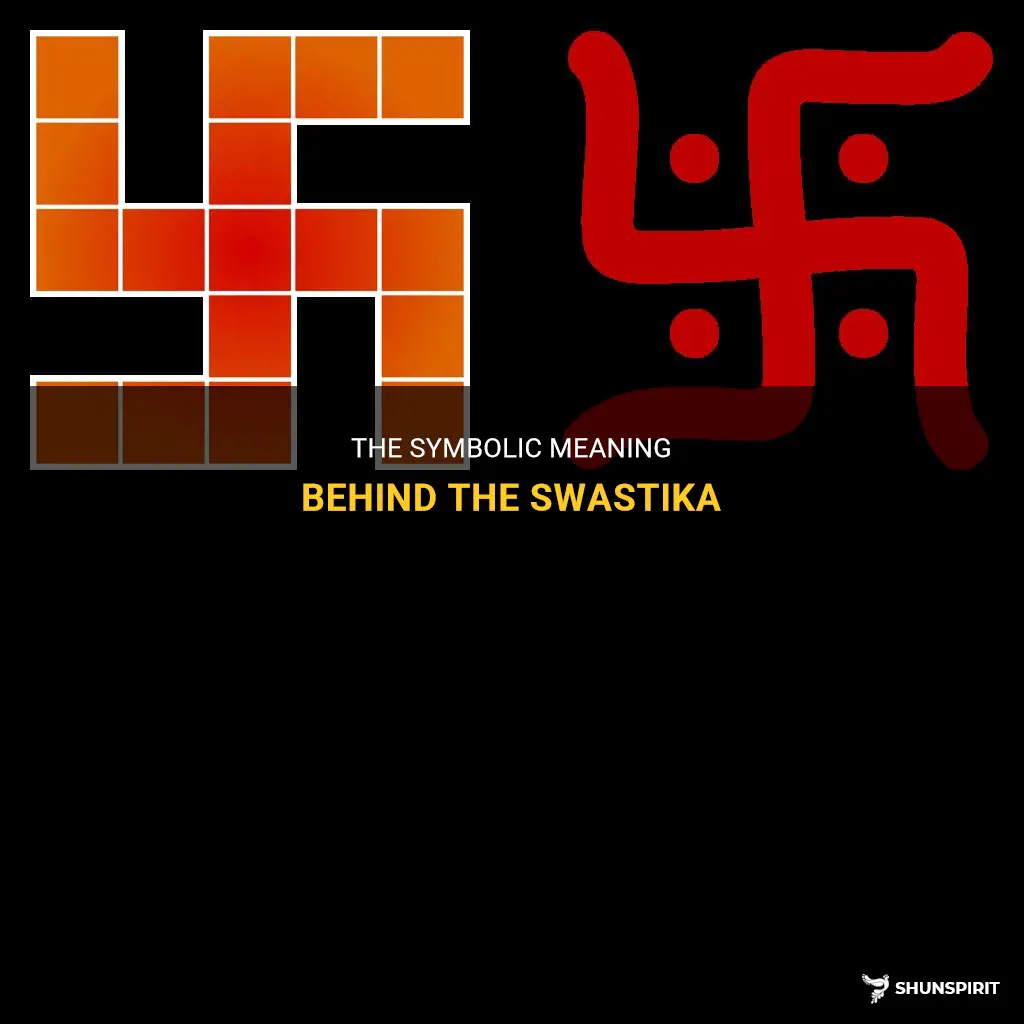
The Swastika symbol has a complex and controversial history, representing different meanings and interpretations throughout the ages. While it is widely recognized today as the emblem of Nazi Germany and the atrocities committed during World War II, its origins can be traced back thousands of years and was initially regarded as a symbol of good fortune, prosperity, and spirituality in ancient civilizations. Understanding the multifaceted nature of the Swastika symbol is key to appreciating its significance and identifying the intricate layers of meaning it has held throughout human history.
What You'll Learn
- What is the meaning of the swastika symbol?
- How has the meaning of the swastika symbol evolved throughout history?
- In which cultures or religions is the swastika symbol traditionally used?
- What are the different interpretations of the swastika symbol in different parts of the world?
- How has the use and interpretation of the swastika symbol changed after its association with the Nazi regime?

What is the meaning of the swastika symbol?
The swastika symbol has a long history and has been used by various cultures around the world for thousands of years. However, in recent times, it has become synonymous with hate and intolerance due to its association with Nazi Germany and Adolf Hitler.
Originating in Sanskrit, the word "swastika" means "well-being" or "good fortune." The symbol itself is a cross with arms bent at right angles, forming a square shape. It can be found in numerous ancient artifacts, such as pottery, jewelry, and buildings, dating back as far as the Neolithic period.
In Hinduism, the swastika is considered sacred and auspicious. It is associated with the sun god, Surya, and the sun's life-giving energy. Many Hindu temples and religious ceremonies feature the swastika as a symbol of good luck and prosperity.
In Buddhism, the swastika is known as the "manji" and is a symbol of eternity and the interconnectedness of all things. It is used extensively in Buddhist art and can be seen on statues, banners, and scriptures.
The swastika also has a presence in other cultures, including ancient European civilizations, Native American tribes, and various East Asian societies. In these contexts, it generally represents positive concepts such as life, luck, and fertility.
Unfortunately, the swastika's association with Hitler's Nazi regime during World War II tarnished its meaning. The Nazis adopted the swastika as their party symbol and used it extensively in their propaganda. Hitler believed that the swastika represented the Aryan race and used it to promote his ideology of racial purity and superiority.
As a result of the Holocaust and the atrocities committed by the Nazis, the swastika became a symbol of hate, genocide, and anti-Semitism. Its use in many countries, including Germany, is now strictly forbidden, except for specific educational or historical purposes.
Despite its negative association in modern times, the swastika remains a significant symbol in many religions and cultures. It is important to recognize its historical context and understand that its meaning extends far beyond its use by the Nazis. By separating the symbol from its misuse, we can appreciate the rich and diverse history behind the swastika.
Unlock the Secrets of Chinese Good Luck Symbols and Their Meanings
You may want to see also

How has the meaning of the swastika symbol evolved throughout history?
The swastika symbol, an ancient religious icon that has been used for thousands of years, has a complex and evolving meaning. It has experienced a significant shift in interpretation over the course of history, particularly in the Western world. Originally a sacred symbol representing good luck and well-being, the swastika became associated with hate and evil during the 20th century due to its adoption by the Nazi party.
The swastika symbol predates the Nazi era by thousands of years and has been found in various ancient civilizations around the world. It has been used in Hinduism, Buddhism, and Jainism, among other religious and cultural traditions. In these contexts, the swastika represents auspiciousness, good fortune, and prosperity. It is often seen as a symbol of the sun and its life-giving energy.
In Hinduism, the swastika is considered one of the most sacred symbols and is often used in religious ceremonies and decorations. It is closely associated with the god Vishnu and is believed to bring prosperity and protection. Similarly, in Buddhism, the swastika is seen as a symbol of the Buddha's footsteps and is used to denote his presence. It represents the interconnectedness of all things and the eternal cycle of life.
However, the meaning of the swastika symbol changed dramatically during the 20th century when the Nazi party adopted it as the centerpiece of their ideology. The swastika became a central part of the Nazi flag and was used extensively in their propaganda and symbolism. Adolf Hitler and his followers inverted the swastika, turning it into a symbol of hate, racism, and genocide.
By associating the swastika with their ideology of Aryan supremacy, the Nazis effectively tarnished the symbol's ancient and positive meanings. The swastika became synonymous with the horrors of the Holocaust and the atrocities committed by the Nazi regime during World War II. Its use by the Nazis and the subsequent association with hatred and genocide has had a lasting impact on the symbol's meaning.
In many Western countries, the swastika is now widely seen as a symbol of hate and is banned or heavily regulated in its use. It is considered offensive and deeply hurtful due to its association with the Holocaust and the millions of lives lost during that period. The negative connotations attached to the swastika have overshadowed its ancient, positive meanings, leaving little room for its original interpretation in many contexts.
However, it is important to note that the swastika still holds its original meanings in many Eastern cultures. In countries like India, Nepal, and Sri Lanka, the swastika continues to be revered as a sacred symbol of prosperity and well-being. It is commonly seen in religious art, architecture, and cultural events, serving as a reminder of its ancient significance and positive connotations.
The evolution of the swastika symbol throughout history is a testament to the power of human interpretation and perception. From its roots as a symbol of good fortune and prosperity to its transformation into a symbol of hate and evil, the swastika's meaning has been deeply influenced by the actions and beliefs of those who have used it. While it may be difficult to separate the symbol from its association with the Nazis, it is important to remember its ancient origins and the diverse perspectives that exist regarding its interpretation.
Decoding the Mystical Meanings of Led Zeppelin's Iconic Symbols
You may want to see also

In which cultures or religions is the swastika symbol traditionally used?
The swastika symbol is an ancient and auspicious symbol that has been used in various cultures and religions throughout history. However, it is important to note that the symbol has taken on a negative connotation due to its association with the Nazi party in Germany during World War II. Despite this association, it is important to remember that the swastika has a much longer and more diverse history.
One of the earliest known uses of the swastika symbol dates back to the ancient Indus Valley Civilization, which existed in present-day India and Pakistan from 3300 to 1300 BCE. The swastika was used as a decorative motif and was considered a symbol of good luck and auspiciousness. It was often depicted in pottery, jewelry, and other artifacts.
In Hinduism, the swastika is considered a sacred symbol and is associated with Ganesha, the elephant-headed god. It is often used to represent good fortune, prosperity, and harmony. The swastika is commonly seen in Hindu temples and is also used in religious ceremonies and festivals.
In Buddhism, the swastika is also a sacred symbol and is associated with Buddha's footprints. It is often used to represent the Buddha's teachings and the path to enlightenment. The swastika is commonly seen on Buddhist temples, statues, and religious artifacts.
In Jainism, the swastika is considered a symbol of the seventh Jain Tirthankara, Suparshvanatha. It is used to represent a number of Jain virtues, including spiritual development, purity, and self-control. The swastika is often seen on Jain temples and is also used in Jain rituals and ceremonies.
The swastika symbol is also found in other cultures and religions around the world. In Native American cultures, such as the Navajo and Hopi tribes, the swastika is considered a sacred symbol and is associated with good luck and protection. It is often used in pottery, jewelry, and other traditional crafts.
In ancient Greece, the swastika symbol was used as a decorative motif and was associated with the sun and the four seasons. It was often used in architectural designs and can be seen on ancient Greek temples and buildings.
In conclusion, the swastika symbol has been traditionally used in various cultures and religions around the world. It has had different meanings and associations depending on the context in which it was used. While it is important to be aware of its negative association with the Nazi party, it is also important to recognize its long and diverse history as a symbol of good luck, auspiciousness, and spirituality.
Decoding the Mysteries: Understanding the Different Car Light Symbol Meanings
You may want to see also

What are the different interpretations of the swastika symbol in different parts of the world?
The swastika symbol is one of the oldest and most widely recognized symbols in the world. However, its meaning and interpretation differ greatly depending on the culture and region in which it is found. While it is commonly associated with Nazi Germany and the horrors of World War II, it has a much richer and varied history that often gets overshadowed.
In Hinduism, Buddhism, and Jainism, the swastika is considered a sacred symbol of prosperity and good fortune. It represents the sun, the cycle of life, and positive energy. The term "swastika" itself is derived from the Sanskrit word "svastika," which means "good health" or "lucky charm." In many temples and religious ceremonies in India and other South Asian countries, the swastika can be seen prominently displayed as a sign of auspiciousness.
In Native American cultures, the swastika is also a symbol of spirituality and divine power. It is often used in Native American art and pottery to represent the four cardinal directions, the four seasons, or the interconnectedness of all things. The Hopi tribe, in particular, used the swastika as a sacred sign long before it was appropriated by the Nazis.
In East Asia, the swastika is known as the "manji" and is a common symbol in Buddhism. It represents the eternal Buddha and the limitless wisdom of the Dharma. Many Buddhist temples in Japan, China, and Korea feature the swastika on their gates or as part of their architectural design.
However, the meaning of the swastika took a dark turn in the early 20th century when Adolf Hitler and the Nazi party adopted it as their emblem. The Nazis combined the swastika with their ideology of Aryan supremacy and used it as a symbol of hate, racism, and genocide. As a result, the swastika became associated with one of the greatest atrocities in human history and is now universally condemned.
In many countries today, the public display of swastikas is banned or highly regulated in order to prevent the spread of hate speech and to respect the sensitivities of Holocaust survivors and victims. However, in some cultures, such as India and Japan, the swastika continues to be used in a positive and non-controversial manner. It is important to remember that the meaning and interpretation of symbols can vary greatly across different cultures and historical contexts.
In conclusion, the swastika symbol has very different interpretations depending on where it is found. While it is often associated with the atrocities of Nazi Germany, it has a long history as a symbol of prosperity, spirituality, and interconnectedness in many other cultures. It is important to understand the complexities and depth of meaning behind symbols and to approach them with cultural sensitivity and historical perspective.
Understanding the Meaning and Significance of Celtic Symbols
You may want to see also

How has the use and interpretation of the swastika symbol changed after its association with the Nazi regime?
The swastika is an ancient symbol that has been used in various cultures and religions for thousands of years. However, its association with the Nazi regime during World War II has forever altered its meaning and interpretation. Prior to the rise of Adolf Hitler and the Nazis, the swastika symbol was used in a positive and sacred context in many regions around the world.
Originating in the Indus Valley civilization, the swastika was widely adopted by Indian religions such as Hinduism, Buddhism, and Jainism. It was seen as a symbol of good luck, eternity, and well-being. In Hinduism, the swastika is associated with the sun and represents the cycle of life, creation, and destruction. In Buddhism, it represents the Buddha's footprints or the wheel of the Dharma. The symbol was also used by Native American tribes, such as the Navajo, to signify the four directions, elements, and the sun.
However, the adoption of the swastika by the Nazi Party in Germany in the 1930s drastically altered its perception. The Nazi swastika, with its tilted orientation and bold colors, became a symbol of hate, racism, and genocide. It represented the ideologies of Adolf Hitler, including Aryan supremacy and the extermination of millions of innocent people during the Holocaust.
Since the end of World War II, the swastika's association with the Nazi regime has made it a highly sensitive and controversial symbol. In many Western countries, the display of the swastika is considered illegal or highly restricted due to its connection to hate crimes and fascist ideologies. Holocaust survivors and their families have expressed deep pain and outrage at the use of the symbol, as it reminds them of the atrocities committed during the Nazi era.
Despite its negative connotations, the swastika still maintains its original positive meaning in some cultures. In India and parts of Asia, it continues to be used in religious ceremonies, as a decorative motif, and as a symbol of good luck and prosperity. However, due to its association with the Nazi regime, its use is often limited to private spaces or specific cultural contexts where its intended meaning is understood and respected.
In recent years, there have been debates and discussions regarding the rehabilitation of the swastika symbol. Some argue for its reclaiming in its original contexts, separate from the Nazi appropriation. This argument emphasizes the symbol's rich history and positive connotations prior to its corruption. However, others argue that the swastika will always be associated with the Nazi regime and its atrocities, and that its use should be permanently condemned.
The use and interpretation of the swastika symbol have undeniably changed after its association with the Nazi regime. It has become a stark reminder of the darkest period in human history, representing hatred, genocide, and white supremacy. While its historical significance and positive connotations continue to be acknowledged in some cultural contexts, it is impossible to separate the swastika from its association with the crimes committed by the Nazis. As a result, its use and display remain highly controversial and polarizing in the modern world.
The Symbolic Meanings and Deep Symbolism of Trees
You may want to see also
Frequently asked questions
The swatski symbol, also known as the swastika, has a complex history and multiple interpretations. In Hinduism, Buddhism, and Jainism, it is considered a sacred symbol representing good fortune, prosperity, and auspiciousness. However, due to its association with Nazism and the atrocities committed during World War II, the swastika has become widely reviled as a symbol of hate and oppression.
The swastika was adopted by Adolf Hitler and the Nazi party in the 1920s, who manipulated its meaning and turned it into a symbol of their fascist ideology. Hitler believed that the Aryan race, which he considered superior, had ancient roots in India, and he saw the swastika as a symbol of Aryan racial purity. The Nazis extensively used the swastika in their propaganda and as an emblem of their regime, forever associating it with their hateful ideology.
The legality of displaying the swastika symbol varies from country to country. In Germany, for example, the public display of swastikas and Nazi symbols is strictly forbidden because of the country's history and laws against promoting Nazi propaganda. In other countries, such as the United States, the legality of displaying the swastika is protected under freedom of speech laws, unless it is used in a manner that incites violence or hatred. However, many countries have laws that prohibit promoting or inciting hatred and discrimination, which can include the public display of swastika symbols in certain contexts.







